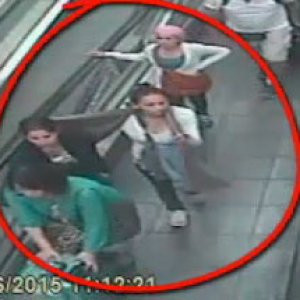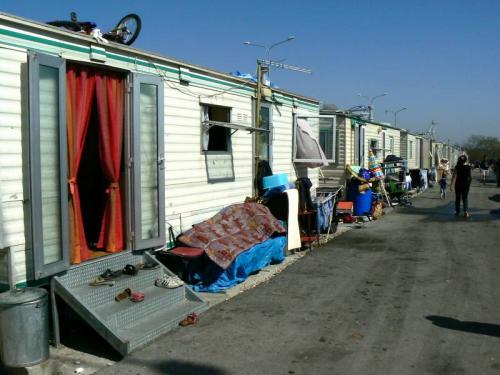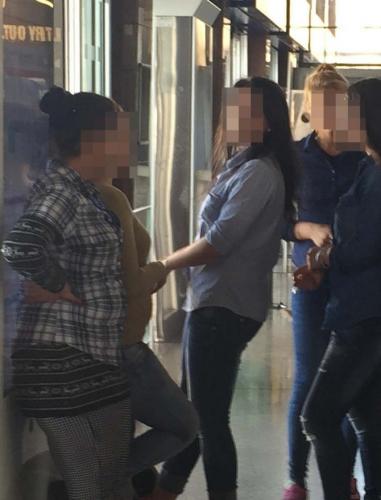School for international pickpockets thrives in Rome

ROME - A young woman dressed in a long, colourful skirt and wearing large, golden earrings roves in front of Termini station. Out of all the tourists and commuters, the woman approaches only elder men. She asks them for a cigarette and engages them in conversation. The men smile, offer her a cigarette and become interested. Now and then, one of the men leaves with the woman. When she reappears in Termini, I try to get her attention. Yet, she deliberately ignores me -- I remember her: Chiara, she said, was her name.
One morning three years ago, a pregnant girl was sweeping the floor in Termini’s busy entrance hall. As other girls cheered and under the watchful eye of two elder women, the girl pretended to be a little housewife. The girls and women belonged to a group that operated at every level of the station. Inside the train carriages and on the platform, they offered tourists to carry their luggage; in the hall, they assisted them with buying tube tickets. Small children begged at the entrance. And in the underground, several units of pre-adolescent girls were stealing. According to TripAdvisor, the Eternal City occupies the number 2 spot on the list of the world’s worst cities for pickpocketing.
Downstairs, on the platform of Underground line B, three young girls are advancing through the crowd. A tiny girl, barely 12, keeps a long scarf over her hands. The doors open. It is a hustle and bustle. The other two girls enter the carriage before a woman wearing a rucksack. The tiny girl follows the woman. The girl does not even mind when I watch as she moves her hands towards the woman’s rucksack. Just before entering the carriage, she sizes me up, as if waiting for my reaction.
A 2015 police inquiry revealed that, in Rome, 40 families control 287 underage pickpockets. The families live in the gypsy camps of Rome and its surroundings. The gang who operated in Termini three years ago was squatting a factory in Aprilia. Magistrate Simonetta Matone stated that current situation reminds her of the early 90s when she and her colleagues monitored a gang of pickpockets. Each morning, a group of children left a camp in the outskirts of Rome for the historical centre. When the magistrate interrogated the children, they all said they left the camp to “go to work.”
I remain on the platform and do not react. While the two girls are blocking the woman, the tiny girl slips her hand in the rucksack.
Last July, the Milan police arrested a 31-year old Bosnian woman. The woman, who is from Rome’s Tor de’ Cenci camp, has spent a lifetime teaching children how to pickpocket in tourist attractions and railway and underground stations. The woman’s first criminal record dates from when she was 16. Already in the late 80s, the trial of a gypsy clan revealed that inside the camps, teachers hid broken mirrors and bells in handbags and coat pockets. The pupils would cut their fingers if they touched the glass fragments and were beaten if the bells rang.
The signal goes off. Just before the doors close, the girls step back and leave the carriage. Without looking back at their victim, they join the crowd. As the train rushes off, the threesome heads for Underground line A.
In “Spagna”, police officers patrol the Underground. If the officers would intercept the girls, they would play on their childish age. Underage pickpockets invariably claim to be younger than 13 knowing that below that age they do not risk any sentence. It is a cat and mouse game: one thief, a 9 year-old girl, has been intercepted as many as 96 times! Even when the police catch an underage thief red-handed, all they can do is escorting the minor to a shelter. Within twenty minutes, the pickpocket will walk free. It seems that one culture, who considers a 13-year old to be an adult, is bullying another culture, who declares that person still an innocent child.
There are mainly tourists in the Underground station beside the Spanish Steps. The girls each carry a handbag over which is folded a jacket. As people become more aware of pickpockets, the latter have to raise the bar of their game. Two years ago, the girls dressed up as tourists and the men who offered assistance with buying tickets suddenly sported ITALIA shirts.
Besides Rome, TripAdvisor’s Top 10 of cities includes Athens, Barcelona, Florence, Madrid, Paris and Prague: all tourist hotspots. As of 2008, the Paris Underground faced a steep increase in the number of underage pickpockets. When caught, they all refused to have their fingerprints or DNA taken. All of them pretended to be younger than 13. All of them said their last name was Hamidovic.
In 2010, the Italian police arrested in Rome a 58 year-old Bosnian gypsy, Fehim Hamidovic. The French police had noticed that many of the pickpockets could only express themselves decently in Italian. The authorities accused Fehim, his wife and their sons of leading a network of pickpockets that spanned from Amsterdam to Lisbon and from Budapest to Paris.
A small woman with a dark complexion and sharp features has sneaked in at the other end of the carriage. She watches the girls like a hawk.
In October 2008, three Hamidovic pickpockets opened up to the police. The girls explained they worked for Jessica Hamidovic. Born in Rome, Jessica, whose real name is Vasvija Ferhatovic, learned to steal at the age of 13. First, she stole for her father. At 15, when she married one of Fehim’s nephews in Spain, she had to obey Fehim’s sister-in-law.
From 2008 until her arrest in 2010, Vasvija led a unit of pickpockets. They roamed the Paris Underground 10 hours per day. “We suffer, we are without education,” she explained during her trial. “All we know is steal, eat, steal.”
Back on line B, the girls take a break in “Piramide”. As they are joking among themselves, they look like close friends –a clique. The girls come across as extravert, unabashed even, but they are very diffident to outsiders. They remind me of Chiara who never ceased asking me questions yet eluded every single of mine. Every day, the Hamidovic girls had until 20 ‘o clock to make 200 euros. If they did not make this amount, their supervisors beat them, burn cigarettes on their bare skin or cut their arms. Thierry Boulouque, Paris’ head of Child Protection, believed the only hope the Hamidovic girls had was to move up the pyramid: becoming a unit head or an expert thief grants a girl more autonomy and liberty.
Two boys briefly join the group. They act as couriers between the centre and the camp so that the loot would not get lost in case the police would intercept the girls. The boys take the Underground to “Laurentina” and from there on a Cotral bus. The bus takes us 30 kilometres out of Rome. On Via Pontina we get off the bus. The boys walk towards a camp. The camp, known as the Castel Romano camp, is the larger of the so-called “villaggi attrezzati” the City of Rome built in order to move the gypsies away from the centre.
Burnt rubbish lies piled up against a concrete wall. The camp and its surroundings resemble a post-atomic landscape. Vans enter and leave the camp. Now and then, a flashy sports car pops up. Last summer, with temperatures reaching 40°C, the camp passed more than a month without running water. When the Roman authorities started to provision the camp with water, the clan heads tried to seize the water in order to make money out of it. The camp also lacks a proper sewage system. Instead, two containers serve to collect and purify all sewage. When the containers cracked, all manure inundated the camp and a scabies epidemic broke out.
A parliamentary intervention revealed that the dwellers of Castel Romano suffer from hepatitis, mange, leptospirosis and leukaemia. In five years’ time, 63 persons died because of the camp’s poor sanitary condition.
Several trailers have been scorched: the clans set alight the trailers of those who do not respect them. Many of Rome’s gypsies originate from ex-Yugoslavia. After the civil war, the Dayton agreement only recognises Serbs, Croatians and Bosnians. The agreement, however, ignores the Roma. Because of this, Roma cannot access the social security system or the labour market. Many Roma children are not even registered in the community registers. Also Roma who emigrated prior to the war are stateless: in Italy for example, 15,000 Roma from ex-Yugoslavia are stateless. And so is their offspring. These nameless and stateless children make ideal material for human traffickers. Olivier Peyroux, a French sociologist and assistant-director of an NGO who helps foreign minors, carried out research in Italy and the Balkans. He observes that, as of 2005, organisations –often families– turned away from street prostitution and started forcing children to commit thefts.
In 2016, the Spanish police arrested a Bosnian couple in Barcelona. The couple led the notorious “clan de las bosnias”, a group of female pickpockets that was responsible for 60% of thefts in the Madrid Underground. They also operated on tourist events such as San Fermín in Pamplona. The couple had been heading networks of pickpockets since 2000 and recruited in Rome’s gypsy camps. The husband, Hasim Sejdic, used to live in Castel Romano.
The Castel Romano camp shelters 600 children. In 2014, only 3.1 percent of the children attended class regularly. Pickpocketing provides the children a means to escape from the camp. After a trial period, the pupils are selected for either stealing or less remunerative tasks. Apt thieves are even subject to financial transactions. Hasim Sejdic charged another clan 5,000 euros for his daughter to steal in the French Riviera during high season. In 2008, police hearings recorded in a camp the mother of a 15 year-old girl telling her daughter’s future mother-in-law : “If Lela marries your son, she will steal for herself and no longer for me. So you deprive me. Therefore, you will have to pay me well. My daughter is an excellent thief and is worth a lot of money.”
On my way back, in “Laurentina”, I spot on the opposite platform another unit of pickpockets. It seems they call it a day. One of the girls is visibly pregnant. A pregnant woman or the mother of a 1 year-old cannot be detained. Female pickpockets often carry an ultrasound scan to prove they are newly delivered mothers.
Bosnian magistrate Diana Kajmakovic, who leads a French-Bosnian investigation on the Salcinovic clan, suspects that its child thieves are born in the gypsy camps of Milan and Rome. The clan lets the mother bond with her child for a short period. Then, they take the child away: it will be raised by a nurse. The young mother can see her child once a year. The remainder of the year, she will have to earn money for herself, her child, the nurse, and the clan. Police hearings recorded clan members telling a mother that her hungry baby would not get food if she did not make 300 euros that day.
Trevi fountain. The square is packed with tourists. Some take pictures or listen to a tour guide whereas others inspect souvenir stalls. Two girls discretely blend into the crowd. They do not look at the marble and water symphony: their eyes are scanning the crowd for purses and wallets. Unlike their peers who are indulging in Italy’ delights, these girls do not have holidays. After a day in the historic centre, they do not relax in a hotel room, but return to a 33 sq M trailer they share with their family –these girls do not even have a bed of their own.
Early morning and Chiara is already in Termini. She is scanning the station for men. She looks older than she is and certainly a lot older than what she looked like three years ago. A far cry from the witty girl I knew.
Vasvija aka “Jessica” had to buy the right to steal in the Paris Underground from one of Fehim’s daughters-in-law. “All my life I have been a slave to many people,” she commented at her trial. “I stole so others could build mansions.” She and her husband have four children: “My entire family steals for Fehim.”
In 1994, in Rome, 15 year-old Sandra met her to-be husband, Robert Baciu, when they both tried to pickpocket the same person. Eighteen years later, Sandra was leading a gang that terrorised Paris’ main tourist attractions up to the point where the staff of the Louvre museum went on strike. By the time the police arrested her in 2013, she had sent 700,000 euros to her husband in his ochre villa in Romania.
Early this year, the Bosnian police detained three pickpockets of the Salcinovic clan. The mug shots show three generations: a teenage girl, an adult woman and a grandmother. The police placed the clan head under a house arrest. He cannot leave his red villa, not even to visit his beloved casinos where, in just one night, he spent 30,000 euros.
The pyramidal clan organisation is constructed of spendthrift men ordering women to send them ever more cash. It is a primitive society where women-gatherers skim the underground for tourists and men-hunters defend the territory from competitors.
I wonder about Chiara’s future. Where is her child and who is taking care of it? And what will it be doing in eight years from now?




